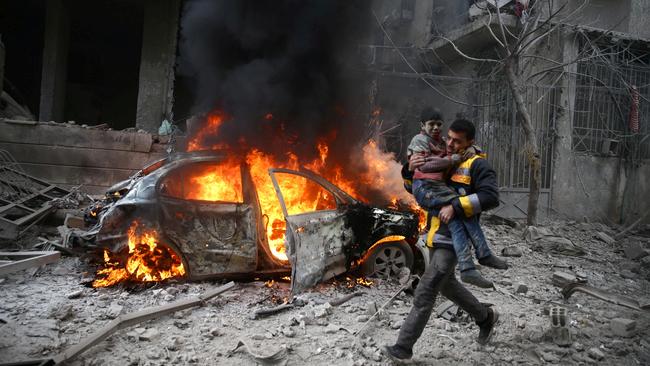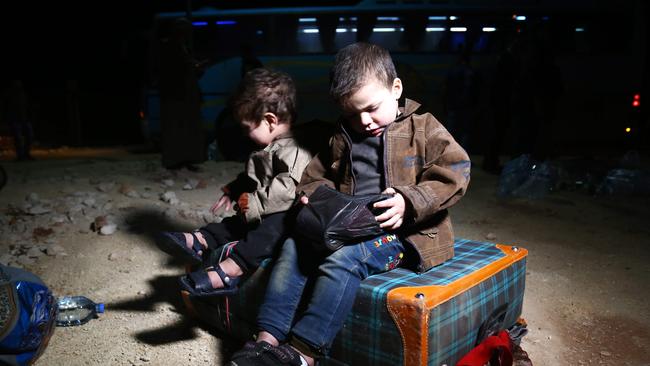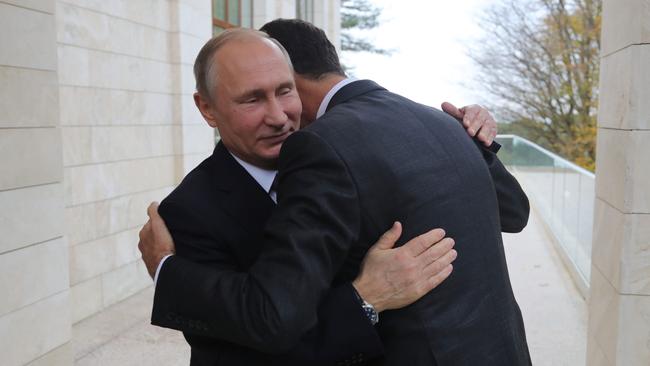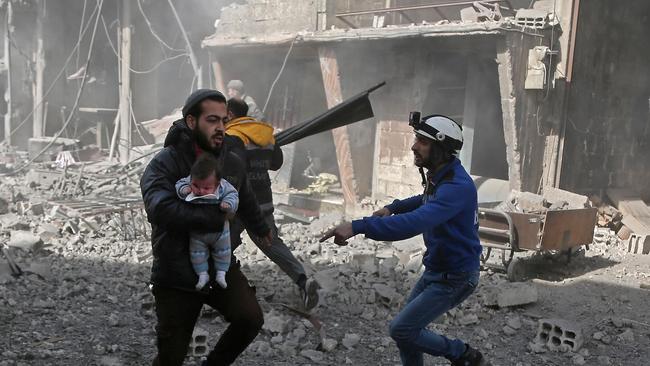Trump’s limited military options in Syria
Can the Assad regime be suitably punished without an escalation that pits the US directly against Russia or Iran?

As night fell on April 7, two Russian-made Mi-8 “Hip” helicopters took off from Dumayr air base, 40km northeast of Damascus, and flew towards Douma, a rebel-held enclave in Ghouta district on the city’s eastern edge. Besides the helicopters, Dumayr hosts two squadrons of Syrian fighter aircraft, plus air defences and ground troops. It has become a key base for the Assad regime’s campaign, dramatically intensified since February, to expel the rebels from Ghouta, crush all remaining pockets of resistance near Damascus and recover thousands of pro-regime hostages held in the area.
As other enclaves folded, Douma became the last holdout. Guerillas in other pockets accepted surrender agreements (often brokered by Russian advisers) that saw them and thousands of their supporters exiled to Idlib, in Syria’s north. From three enclaves and 400,000 people under rebel control in February, Ghouta by last weekend was down to less than 100,000 rebel-controlled residents and one remaining pocket of resistance, in Douma. Guerillas there — mostly from Jaish al-Islam, an Islamist group backed by Saudi Arabia and aligned with Ahrar al-Sham, one of Syria’s major Sunni rebel organisations — repeatedly rejected a deal. In response, the regime launched a series of increasingly intense bombardments using high explosives and chemical munitions.
Douma already had been under attack all day on April 7. At noon, regime aircraft bombed the Red Crescent hospital, destroying ambulances and putting the clinic out of action. Two missiles struck the same area, and rescuers were targeted as they evacuated the wounded. Then, at 4pm, another airstrike hit the nearby Sa’ada bakery with chemical munitions containing chlorine gas, causing at least 25 casualties. Just before 7.30pm, observers on the ground saw the two helicopters over Douma, and shortly thereafter civilians began streaming out of an apartment building, suffering from choking, and burning eyes (typical of chlorine) but also pinpoint pupils, erratic heartbeat, convulsions and foaming at the mouth — symptoms indicating nerve agent. Many had been trapped in basements and corridors, sheltering from the high-explosive barrel bombs, concentrated in confined spaces that left them highly vulnerable to the gas and unable to flee in time.
Investigators later found two yellow gas cylinders lodged on the roof and in an upper floor, of a type often used by the regime for chemical attacks. The toll from the apartment block was at least 42 civilians dead and 500 injured, including many children — which, by the gruesome standards of Syria in its eighth year of war, is actually relatively low. Still, the attack seems to have done the trick: within 24 hours, Jaish al-Islam surrendered, released its hostages and began leaving for Idlib in a convoy of buses under Russian escort.
Regime forces entered Douma, Russian teams moved to the gas attack site (allegedly to investigate who could have been responsible, but also to prevent others from examining the evidence), and Bashar al-Assad’s control of the region was almost complete. Russian-backed social media accounts immediately began denying any nerve gas attack, well before anyone had even accused the Russians or the regime of involvement.
As Trump and his new National Security Adviser, John Bolton — who clearly is having a busy first week on the job — meet military and intelligence officials to consider their response, the consolidation of regime control represents one of the key military factors they need to take into account.

Assad has effectively won the war for Syria’s heartland. His regime controls the capital, the coastline, key cities and a buffer zone extending to the Euphrates river, its de facto partition line with Kurdish groups in the northeast. As Hezbollah (a regime ally) secures a strip of territory along the mountainous border with Lebanon and Turkey builds a new buffer zone in Syria’s north, Islamic State has been reduced to a couple of small pockets of territory (with no major cities).
The Syrian regime’s position, propped up by Russia and Iran, looks more secure than at any time since about 2012.
Thus, there’s no prospect that Western military action now may change the ultimate outcome of the war — rather, any strike will serve the more limited goal of re-establishing international norms against the use of chemical weapons, especially nerve agents, norms the Assad regime repeatedly has disregarded and periodically been punished for flouting, most recently in Trump’s cruise missile strike against Shayrat air base in April last year.
That strike failed to halt Assad’s use of chemical weapons against his own people, but it did have three major effects that Trump’s advisers also have been forced to ponder this week.
First, in late April last year, a few weeks after the Shayrat strike, Assad moved many of his most advanced combat aircraft on to Russian-controlled air bases, such as the large Russian base at Khmeimim near the coastal city of Latakia. This put Syrian aircraft under the umbrella of Russian air defences — including capable S-400 missile systems, shorter-range Pantsir-S1 missiles that can shoot down incoming aircraft or cruise missiles, and Russian combat aircraft that patrol the skies over Syria — raising the risk that future strikes would fail to do much damage, while suffering serious losses.
Second, even on smaller bases such as Dumayr, Russian or Iranian assets and personnel are heavily intermingled with Syrian forces. This means a future strike also may accidentally hit Russians or Iranians, escalating the conflict. Partly in response to this, back in 2016 the US and Russia created a so-called “de-confliction hotline” in the US Air Force coalition intelligence fusion cell at al-Udeid Air Base in Qatar, which allows them to warn each other of impending activity. After last year’s strike, Russia threatened to close the hotline but ultimately kept it open, and this week Kremlin spokesman Dmitri Peskov confirmed it was still in use. Despite this, the danger of collateral damage that could bring US and Russian forces into direct military conflict in Syria is far from trivial.
Finally, and most significantly, last August Syria and Russia announced the integration of their air defence systems, creating a unified anti-aircraft and missile defence umbrella over Syria and surrounding countries, and linking Russian missiles and combat aircraft (based at Kheimim and elsewhere) into a co-ordinated effort to deter or defeat hostile strikes.
Those systems have rarely been used — they remained inactive during an Israeli raid on the T-4 air base in central Syria last Monday, but this was probably to avoid activating air defence radars, which would have exposed their locations.
This suggests that future action would face much tougher air defences than last year’s strike, which was already so dangerous that Trump chose to restrict it to Tomahawk cruise missiles, rather than put American or coalition pilots in harm’s way.
That strike — which involved 59 missiles — did little to prevent regime atrocities: though up to 20 aircraft were destroyed, Shayrat was back in action and launching air raids within 24 hours, prompting critics to deride it as a pinprick.
This brings us to the key political consideration: given that last year’s attack had such little effect, and that it tied Trump’s reputation to preventing or punishing Syrian chemical attacks, any new strike would need to be significantly larger than Shayrat to be credible. Like it or not, and despite his recent attempts on Twitter to weasel out of it, Trump now owns the Obama administration’s “red line” — for which Trump, as a private citizen in 2013 and later as presidential candidate, repeatedly criticised Barack Obama. A mere repeat of Shayrat (or a failure to strike) would make the President look politically weak, while larger action — with or without allies — would involve far greater risk.
This was clear on Wednesday, when Trump tweeted: “Russia vows to shoot down any and all missiles fired at Syria. Get ready Russia, because they will be coming, nice and new and ‘smart!’ You shouldn’t be partners with a Gas Killing Animal who kills his people and enjoys it!”

The US news media (evidently with little sense of irony) quickly pivoted from accusing Trump of colluding with Russia to warning of the danger that his tough talk might provoke a military confrontation with Moscow. This prompted White House press secretary Sarah Huckabee Sanders to observe mordantly: “Now I guess people are concerned that we’re being tough on Russia. I guess I’m confused on which way you want to have it.”
More important, the President’s tweets — driven, as always, by short-term political factors — prompted alarm among senior analysts that he was telegraphing the time, location and method for a military strike still in its planning stages, something that is not only anathema to military planners but also was one of Trump’s harshest criticisms against Obama.
Retired general Ben Hodges, former head of the US Army in Europe and no stranger to Russian aggression or the need for operational security, called the President’s tweet “appalling”, while Pentagon officials privately pointed out that US naval assets in range of Syria (and from which the missiles the President mentioned would come) were now at increased risk.
Given these factors, how might a potential strike play out?
There are ample assets available, including American missile-equipped ships already in the eastern Mediterranean, as well as the USS Harry S. Truman carrier battle group, which was ordered to the area this week. Carrier-based strike aircraft from the Persian Gulf, along with land-based aircraft from al-Udeid in Qatar and other bases in the region, could become involved but, given the heightened anti-aircraft threat, a strike involving mainly missiles launched from surface ships or submarines is likelier.
If French, British or Saudi forces become engaged (as all three governments have suggested they might under the right circumstances), then French naval aircraft and missiles might be involved, as would British bombers and strike aircraft from Cyprus and Saudi land-based aircraft, along with missiles launched from ships or submarines.
The more important question is targeting. Given the intermingling of Russian, Iranian and Syrian assets and the integrated Russian-Syrian air defence system in place, the chance that a strike could succeed in disabling the bulk of Syria’s air force, or destroying its air defences, is low, while the risk of Western losses — of missiles or, far more significantly, pilots — would be high, perhaps unacceptably so. One option would be to strike ground units or proxy forces, but these often include embedded Russian or Iranian advisers, raising the risk of further escalation.
A final choice — though a highly radical one — might be to attempt what is known as a regime decapitation strike, going after Assad, senior members of his government or facilities such as his presidential palace.
My impression is that officials involved in the discussions would be unlikely to recommend that, but it is not off the table (although locating Assad with sufficient precision to strike him without serious risk of collateral damage would be another matter).
Besides the defensive response of shooting down incoming missiles or aircraft, planners are also likely considering potential retaliation from the Syrian regime or its Russian, Iranian and Hezbollah allies, whether directly within Syria or farther afield.
US special forces advisers and their partner forces have already been attacked by the regime (and by Russian mercenaries, most notably in a February engagement that left up to 200 Russians dead). One likely retaliatory target would be US advisers embedded with the Syrian Democratic Forces, a US-backed rebel group in northeast Syria, while another would be the US base at al-Tanf in the country’s southeast, where US advisers are assisting the Syrian Arab Coalition, a secular rebel group that opposes both the Assad regime and Islamic State.
All this is to say that as long as US troops and their partners remain in Syria, the regime and its allies will always have ready targets to attack in retaliation.

Perhaps this is why, only a few days before the Douma attack, Trump called for a complete US withdrawal from Syria within the next six months.
It’s perhaps hard to remember now — 10 days is an eternity in Trump’s Twitterverse, and he has held a multiplicity of attitudes on the issue since then — but on April 3 and 4 the President was insisting on full withdrawal from Syria, claiming the near-total defeat of Islamic State, and saying it was time for others to take on the role of cleaning up and rebuilding.
He was clearly indicating an intent to disengage, and given the overall military context, US disengagement could only mean acquiescing to the already near-complete reimposition of regime control across Syria’s heartland, and perhaps the expansion of Turkey’s buffer zone to crowd out US-backed Kurdish forces in the north. The Douma attack followed within days.
All this suggests that even as the President and his advisers ponder their options for a response to the latest atrocity, it might be worth considering whether their own statements — telegraphing an intent to leave, suggesting that others take over from here — might have emboldened the regime to launch the attack in the first place.
Trump’s immediate 180-degree reversal after the attack — flip-flopping from getting out, to launching a strike; from handing control to Russia and Assad, to boasting of incoming missiles — must have left people reeling.
To paraphrase spokeswoman Sanders, Russia, Iran and Syria may be “confused as to which way the President wants to have it”.
Before deciding on the tactical issue of where and how to strike, Trump would do well to consider that longer-term strategic question first.
David Kilcullen is a former lieutenant-colonel in the Australian Army and was a senior adviser to US general David Petraeus in 2007-08, when he helped to design the Iraq war coalition troop surge. He also was a special adviser for counterinsurgency to former US secretary of state Condoleezza Rice. He is the author of Blood Year: Islamic State and the Failures of the War on Terror (Black Inc).




To join the conversation, please log in. Don't have an account? Register
Join the conversation, you are commenting as Logout